Electrodeposition and Corrosion Behavior of Cu-Sn Alloys in 3.5 wt.% NaCl and 0.1 M HNO3 Solutions
Abstract
1. Introduction
2. Materials and Methods
2.1. Synthesis of Cu-Sn Alloys
2.2. Structural Characterization
2.3. Electrochemical Measurements
3. Results and Discussion
3.1. Morphology and Structure of Cu-Sn Alloys
3.2. Adhesion Test Analysis
3.3. Polarization Behavior in 3.5 wt.% NaCl Solution
3.4. Polarization Behavior in 0.1 M HNO3 Nitrate Solution
3.5. Electrochemical Impedance Spectroscopy
3.6. Microscopic Morphology of Corrosion Products
3.7. Analysis of Electronic Valence States in the Corrosion Reactions of Cu56Sn44 and Cu43Sn57 Alloys
4. Conclusions
Author Contributions
Funding
Data Availability Statement
Acknowledgments
Conflicts of Interest
References
- Faiyaz Ahmed, A.; Ibrahim Shaikh, M.; Ali, Z. Investigations on mechanical behaviour of nano zirconium oxide and graphite particles reinforced copper-tin alloy metal composites. Mater. Today Proc. 2023, 92, 849–855. [Google Scholar] [CrossRef]
- Huttunen-Saarivirta, E.; Isotahdon, E.; Carpén, L. Behaviour of leaded tin bronze in simulated seawater in the absence and presence of tribological contact with alumina counterbody: Corrosion, wear and tribocorrosion. Tribol. Int. 2019, 129, 257–271. [Google Scholar] [CrossRef]
- Sun, B.; Zuo, X.; Li, X. The role of chromium content in the long-term atmospheric corrosion process. npj. Mater. Degrad. 2020, 4, 37. [Google Scholar] [CrossRef]
- Ghosh, S.; Roy, S. Codeposition of Cu-Sn from Ethaline Deep Eutectic Solvent. Electrochim. Acta 2015, 183, 27–36. [Google Scholar] [CrossRef]
- Hu, R.Z.; Zhang, Y.; Zhu, M. Microstructure and electrochemical properties of electron-beam deposited Sn–Cu thin film anodes for thin film lithium ion batteries. Electrochim. Acta 2008, 53, 3377–3385. [Google Scholar] [CrossRef]
- Low, C.T.J.; Walsh, F.C. Electrodeposition of tin, copper and tin–copper alloys from a methanesulfonic acid electrolyte containing a perfluorinated cationic surfactant. Surf. Coat. Technol. 2008, 202, 1339–1349. [Google Scholar] [CrossRef]
- Pewnim, N.; Roy, S. Electrodeposition of tin-rich Cu–Sn alloys from a methanesulfonic acid electrolyte. Electrochim. Acta 2013, 90, 498–506. [Google Scholar] [CrossRef]
- Saba, T.; Saad, K.S.K.; Rashid, A.B. Precise surface engineering: Leveraging chemical vapor deposition for enhanced biocompatibility and durability in biomedical implants. Heliyon 2024, 10, e37976. [Google Scholar] [CrossRef]
- Najah, M.N.; Rahmania, F.A.; Nur, H. Parameter influences of FTO/ZnO/Cu2O photodetectors fabricated by electrodeposition and spray pyrolysis techniques. S. Afr. J. Chem. Eng. 2025, 51, 188–201. [Google Scholar] [CrossRef]
- Wang, T.; Li, W.; Meng, J. A novel and facile synthesis of black TiO2 with improved visible-light photocatalytic H2 generation: Impact of surface modification with CTAB on morphology, structure and property. Appl. Surf. Sci. 2017, 426, 325–332. [Google Scholar] [CrossRef]
- Walsh, F.C.; Wang, S.; Zhou, N. The electrodeposition of composite coatings: Diversity, applications and challenges. Curr. Opin. Electrochem. 2020, 20, 8–19. [Google Scholar] [CrossRef]
- Guan, T.; Zhang, N. Recent Advances in Electrodeposition of Nickel-Based Nanocomposites Enhanced with Lubricating Nanoparticles. Nanomanuf. Metrol. 2024, 7, 25. [Google Scholar] [CrossRef] [PubMed]
- Bengoa, L.N.; Pary, P.; Egli, W.A. Electrodeposition of Cu-Sn alloys from a methanesulfonic acid electrolyte containing benzyl alcohol. Electrochim. Acta 2017, 256, 211–219. [Google Scholar] [CrossRef]
- Meng, G.; Sun, F.; Wang, F. Effect of electrodeposition parameters on the hydrogen permeation during Cu–Sn alloy electrodeposition. Electrochimi. Acta 2010, 55, 2238–2245. [Google Scholar] [CrossRef]
- Zhang, S.; Nishi, Y.; Kubota, Y. Efficient synthesis of MSE-type zeolite using a highly effective organic structure-directing agent and excellent catalytic performance of its derived titanosilicate. Microporous Mesoporous Mater. 2025, 384, 113452. [Google Scholar] [CrossRef]
- Shi, Z.; Wang, L.; Liu, J. Designing organic structure-directing agent for cost-effective production of multipore MSE zeolite. Fuel 2025, 381, 133274. [Google Scholar] [CrossRef]
- Mallette, A.J.; Espindola, G.; Rimer, J.D. Highly efficient synthesis of zeolite chabazite using cooperative hydration-mismatched inorganic structure-directing agents. Chem. Sci. 2024, 15, 573–583. [Google Scholar] [CrossRef]
- Su, F.; Yao, K. Facile Fabrication of Superhydrophobic Surface with Excellent Mechanical Abrasion and Corrosion Resistance on Copper Substrate by a Novel Method. ACS. Appl. Mater. Int. 2014, 6, 8762–8770. [Google Scholar] [CrossRef]
- Esmailzadeh, S.; Khorsand, S.; Ashrafizadeh, F. Microstructural evolution and corrosion resistance of super-hydrophobic electrodeposited nickel films. Surf. Coat. Technol. 2015, 283, 337–346. [Google Scholar] [CrossRef]
- Benea, L.; Caron, N.; Raquet, O. Tribological behavior of a Ni matrix hybrid nanocomposite reinforced by titanium carbide nanoparticles during electro-codeposition. RSC Adv. 2016, 6, 59775–59783. [Google Scholar] [CrossRef]
- Diaz, L.A.; Coppola, R.E.; Ocón, P. Alkali-doped polyvinyl alcohol—Polybenzimidazole membranes for alkaline water electrolysis. J. Membr. Sci. 2017, 535, 45–55. [Google Scholar] [CrossRef]
- Zhu, X.; Tian, J.; Shan, Z. A novel compact cathode using sponge-like RANEY® nickel as the sulfur immobilizer for lithium–sulfur batteries. RSC Adv. 2017, 7, 35482–35489. [Google Scholar] [CrossRef]
- Zhao, C.X.; Liu, J.N.; Zhang, Q. Multiscale Construction of Bifunctional Electrocatalysts for Long-Lifespan Rechargeable Zinc–Air Batteries. Adv. Funct. Mater. 2020, 30, 2003619. [Google Scholar] [CrossRef]
- Jiang, S.W.; Yang, L.; Wang, Z.Q. Electrodeposition of Ni-Al2O3 composite coatings with combined addition of SDS and HPB surfactants. Surf. Coat. Technol. 2016, 286, 197–205. [Google Scholar] [CrossRef]
- Li, X.; Gao, R.; Sun, L. Study of deposition patterns of plating layers in SiC/Cu composites by electro-brush plating. Appl. Surf. Sci. 2011, 257, 10294–10299. [Google Scholar] [CrossRef]
- Sivasakthi, P.; Sangaranarayanan, M.V. Pulse electrodeposited nickel with structure directing agents as an electrocatalyst for oxidation of glycerol. New J. Chem. 2019, 43, 8352–8362. [Google Scholar] [CrossRef]
- Zhang, M.; Shi, Y.; Guan, R. Micelle-assisted electrodeposition of mesoporous PtCo nodular films and their electrocatalytic activity towards the hydrogen evolution reaction in acidic media. Fuel 2025, 381, 133288. [Google Scholar] [CrossRef]
- Chen, Y.; Zhang, J.; Guan, R. Magnetic field-controlled bubble templated CuNi foam films and their performance towards hydrogen evolution reaction in alkaline media. Int. J. Hydrogen Energy 2024, 59, 625–634. [Google Scholar] [CrossRef]
- Eiler, K.; Fornell, J.; Sort, J. Tailoring magnetic and mechanical properties of mesoporous single-phase Ni–Pt films by electrodeposition. Nanoscale 2020, 12, 7749–7758. [Google Scholar] [CrossRef]
- Eugénio, S.; Silva, T.M.; Montemor, M.F. Electrodeposition and characterization of nickel–copper metallic foams for application as electrodes for supercapacitors. J. Appl. Electrochem. 2014, 44, 455–465. [Google Scholar] [CrossRef]
- Laschuk, N.O.; Easton, E.B.; Zenkina, O.V. Reducing the resistance for the use of electrochemical impedance spectroscopy analysis in materials chemistry. RSC Adv. 2021, 11, 27925–27936. [Google Scholar] [CrossRef] [PubMed]
- Zhou, Q.; Li, G.; Li, R. Preparation and antioxidation of Cu-Sn composite coating on the surface of Cu-coated carbon fibers. Surf. Interf. 2022, 31, 102016. [Google Scholar] [CrossRef]
- Liao, X.-N.; Cao, F.-H.; Cao, C.-N. In-situ investigation of atmospheric corrosion behavior of bronze under thin electrolyte layers using electrochemical technique. Trans. Nonferrous Met. Soc. China 2012, 22, 1239–1249. [Google Scholar] [CrossRef]
- Yang, X.; Wu, W.; Chen, K. Investigation on the electrochemical evolution of the Cu-sn-Pb ternary alloy covered with CuCl in a simulated atmospheric environment. J. Electroanal. Chem. 2022, 921, 116636. [Google Scholar] [CrossRef]
- Kear, G.; Barker, B.D.; Walsh, F.C. Electrochemical corrosion of unalloyed copper in chloride media––A critical review. Corros. Sci. 2004, 46, 109–135. [Google Scholar] [CrossRef]
- Chmielová, M.; Seidlerová, J.; Weiss, Z. X-ray diffraction phase analysis of crystalline copper corrosion products after treatment in different chloride solutions. Corros. Sci. 2003, 45, 883–889. [Google Scholar] [CrossRef]
- Grayburn, R.; Dowsett, M.; Adriaens, A. Tracking the progression of bronze disease—A synchrotron X-ray diffraction study of nantokite hydrolysis. Corros. Sci. 2015, 91, 220–223. [Google Scholar] [CrossRef]
- Wang, T.; Wang, J.; Wu, Y. The inhibition effect and mechanism of l-cysteine on the corrosion of bronze covered with a CuCl patina. Corros. Sci. 2015, 97, 89–99. [Google Scholar] [CrossRef]
- Khaled, K.F.; Fadl-Allah, S.A.; Hammouti, B. Some benzotriazole derivatives as corrosion inhibitors for copper in acidic medium: Experimental and quantum chemical molecular dynamics approach. Mater. Chem. Phys. 2009, 117, 148–155. [Google Scholar] [CrossRef]
- Kellenberger, A.; Vaszilcsin, N.; Duteanu, N. Kinetics of hydrogen evolution reaction on skeleton nickel and nickel–titanium electrodes obtained by thermal arc spraying technique. Int. J. Hydrogen Energy 2007, 32, 3258–3265. [Google Scholar] [CrossRef]
- Li, B.; Qu, H.; Chen, H. Copper alloying content effect on pitting resistance of modified 00Cr20Ni18Mo6CuN super austenitic stainless steels. Corros. Sci. 2020, 173, 108791. [Google Scholar] [CrossRef]
- Meddings, N.; Heinrich, M.; Park, J. Application of electrochemical impedance spectroscopy to commercial Li-ion cells: A review. J. Power. Sources 2020, 480, 228742. [Google Scholar] [CrossRef]
- Gateman, S.M.; Gharbi, O.; Vivier, V. On the use of a constant phase element (CPE) in electrochemistry. Curr. Opin. Electrochem. 2022, 36, 101133. [Google Scholar] [CrossRef]
- Tsao, L.C.; Chen, C.W. Corrosion characterization of Cu–Sn intermetallics in 3.5wt.% NaCl solution. Corros. Sci. 2012, 63, 393–398. [Google Scholar] [CrossRef]
- Zeng, C.; Zhang, B.; Guo, S. Mechanical, thermal, and corrosion properties of Cu-10Sn alloy prepared by laser-powder-bed-fusion additive manufacturing. Addit. Manuf. 2020, 35, 101411. [Google Scholar] [CrossRef]
- Feng, Y.; Teo, W.K.; Hsieh, A.K. The corrosion behaviour of copper in neutral tap water. Part I: Corrosion mechanisms. Corros. Sci. 1996, 38, 369–385. [Google Scholar] [CrossRef]
- Barcia, O.E.; D’Elia, E.; Tribollet, B. Application of the impedance model of de Levie for the characterization of porous electrodes. Electrochim. Acta 2002, 47, 2109–2116. [Google Scholar] [CrossRef]
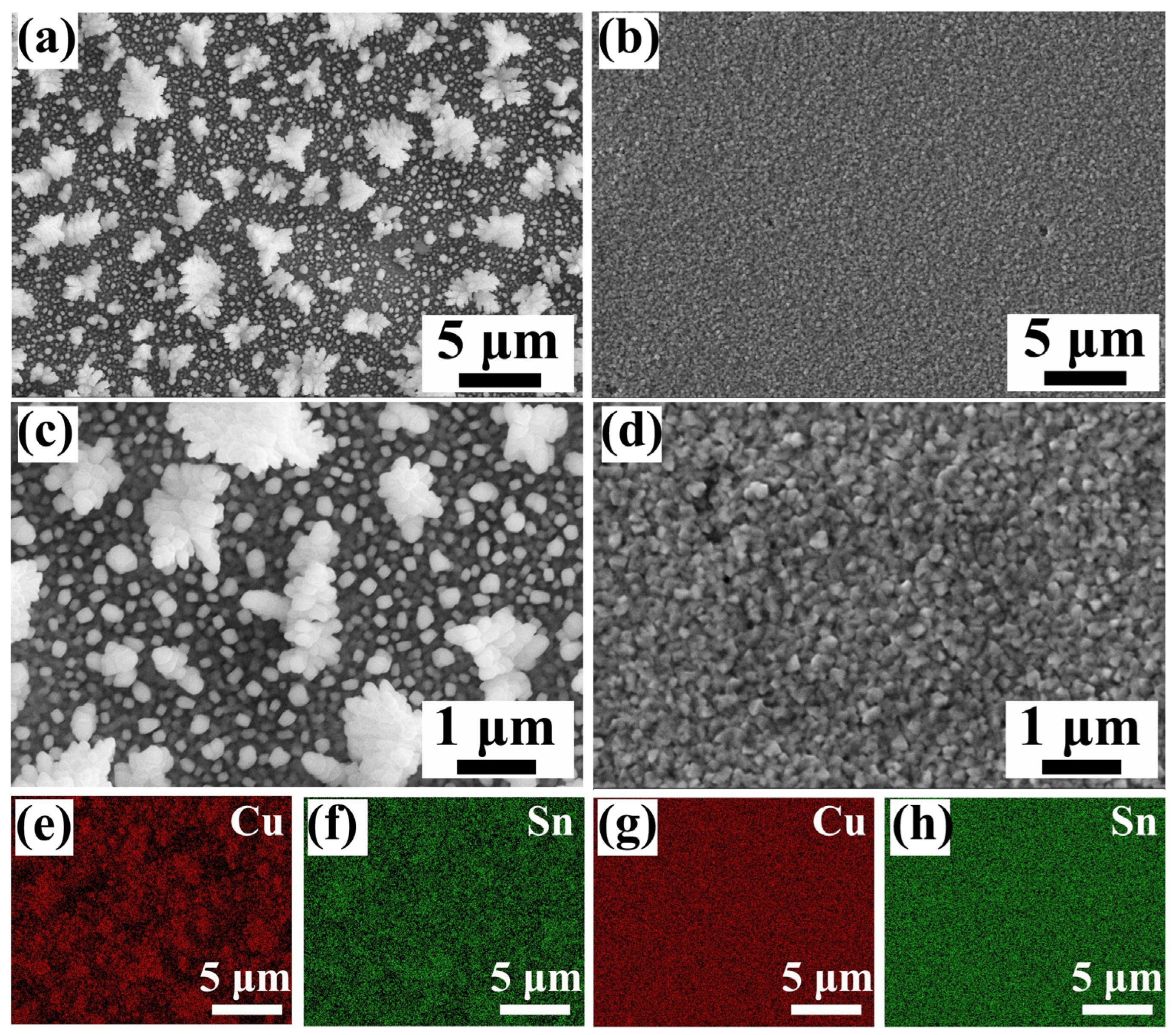
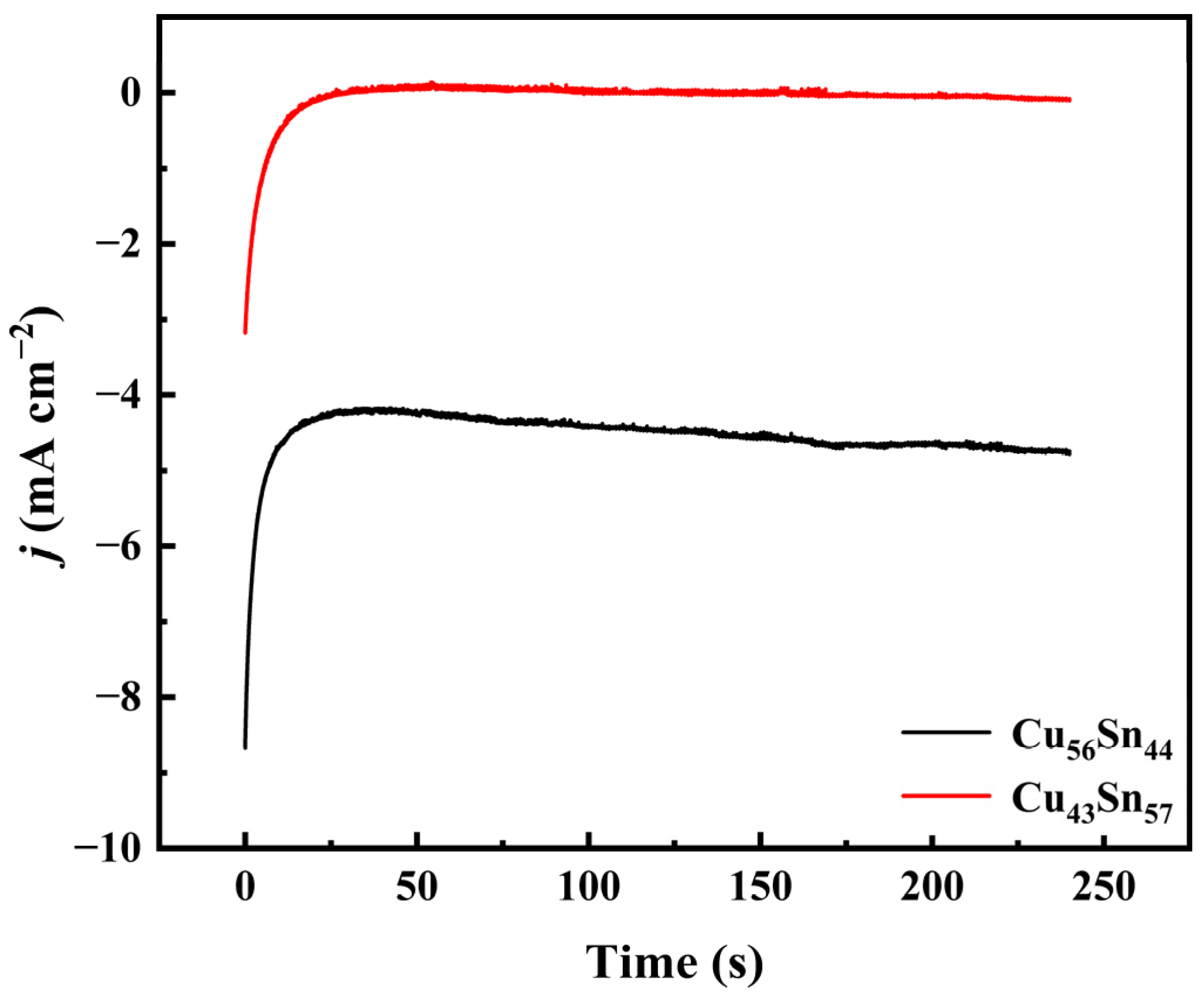
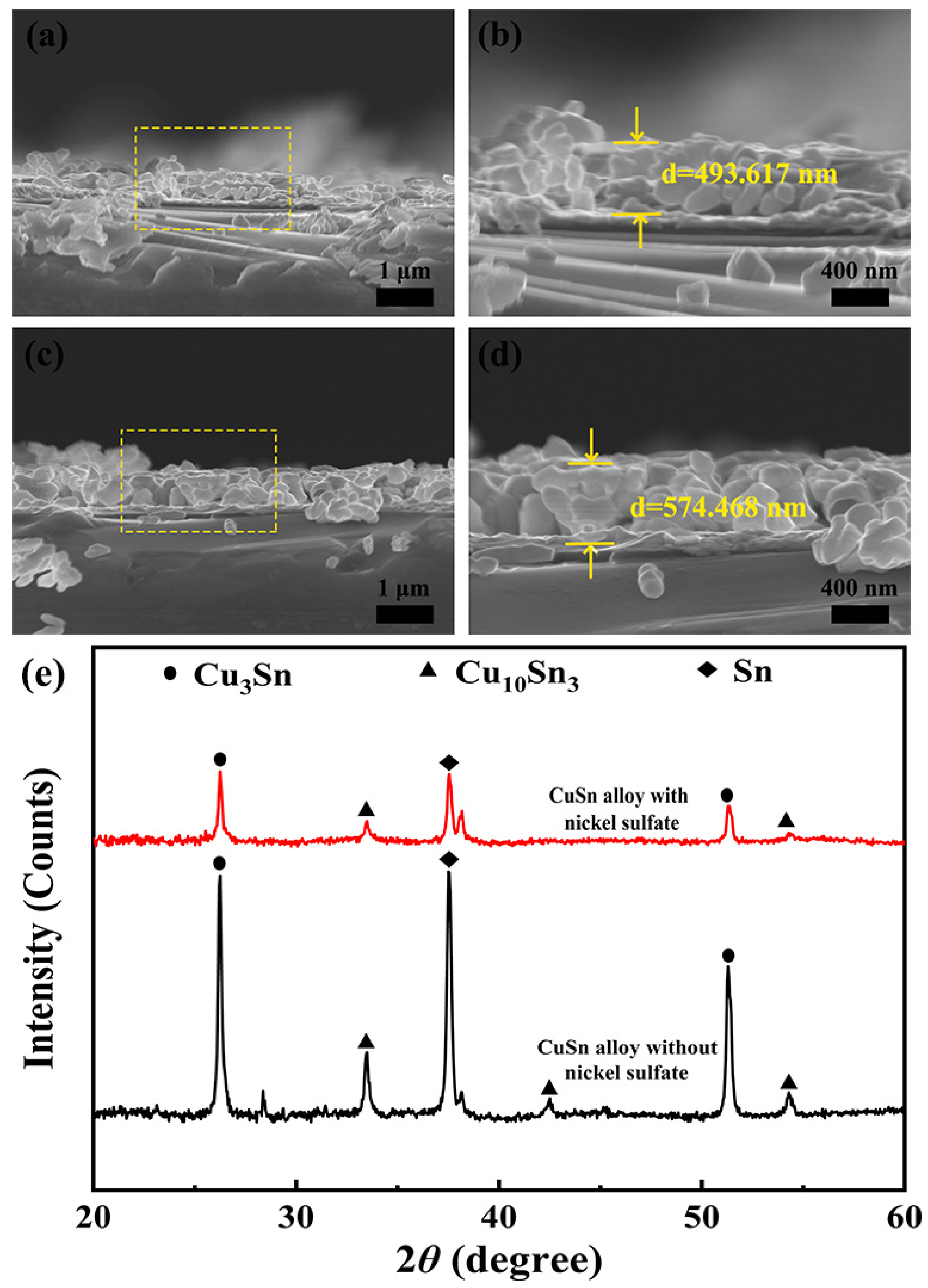
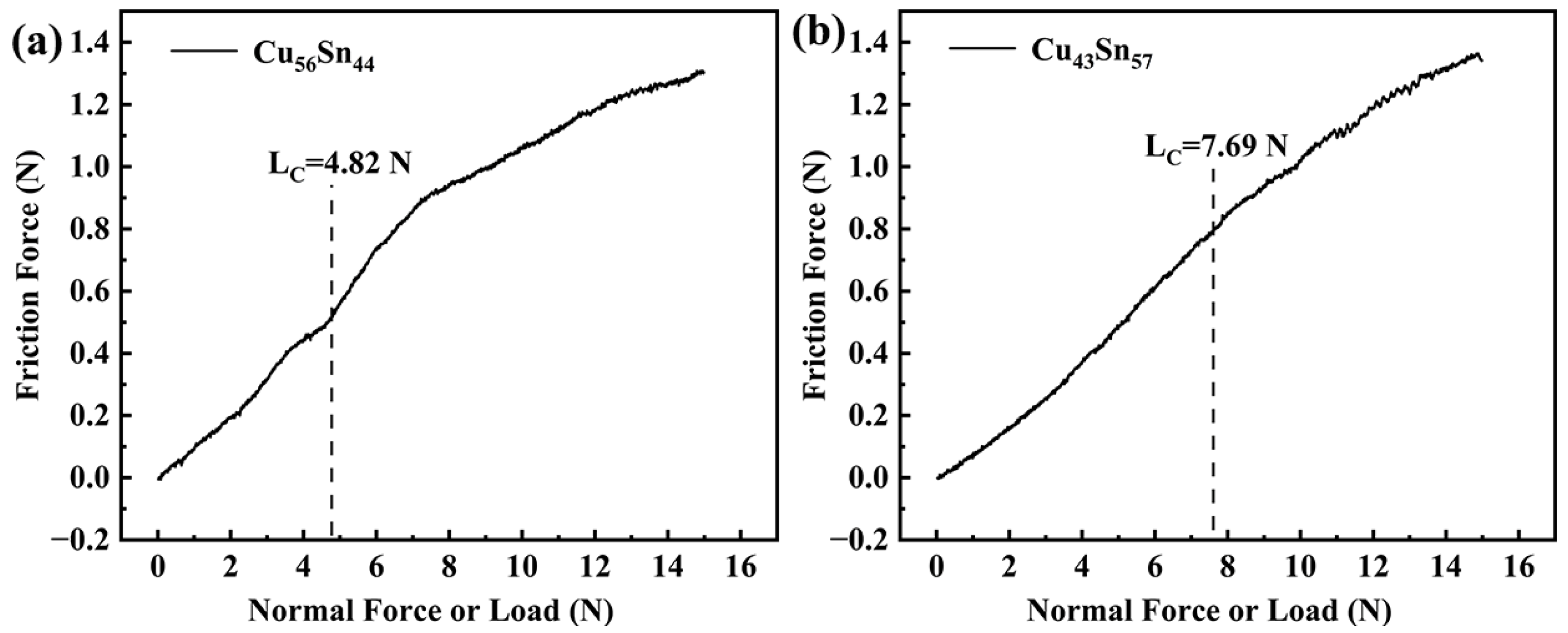
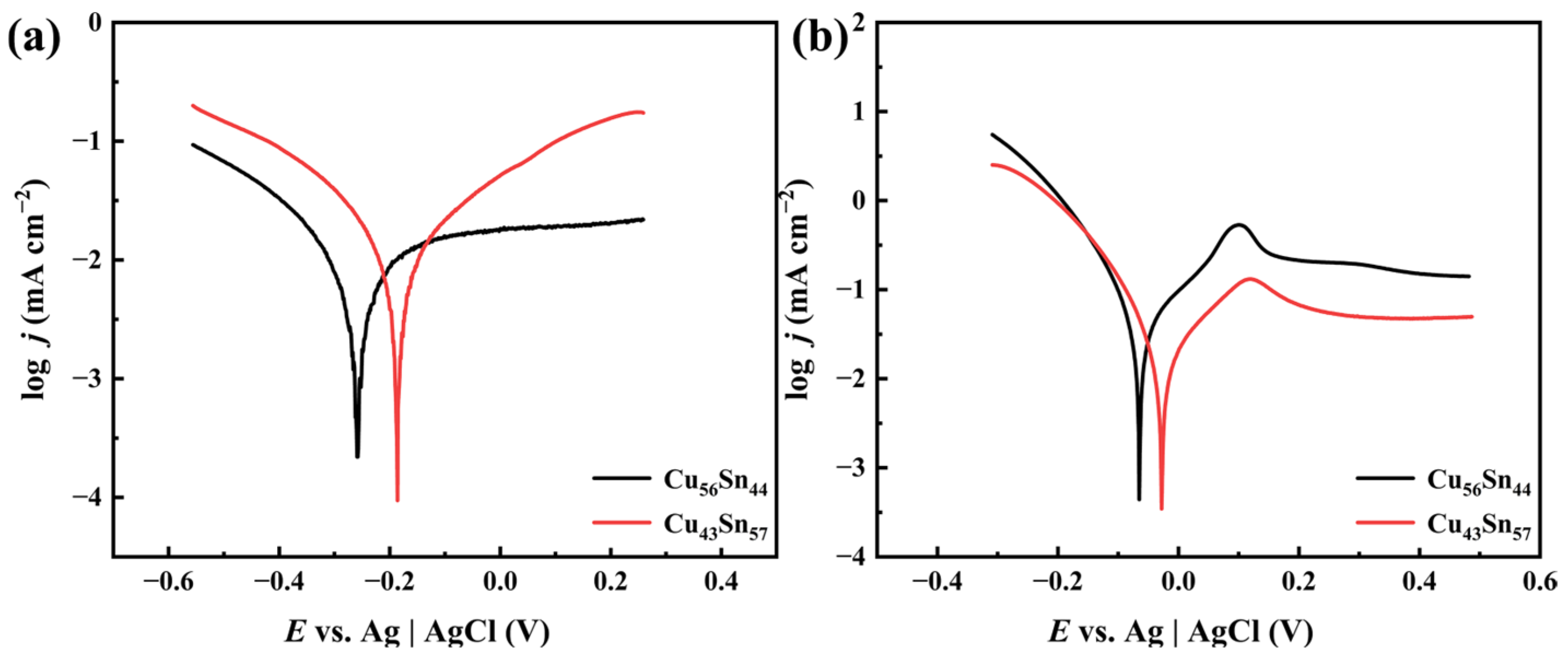

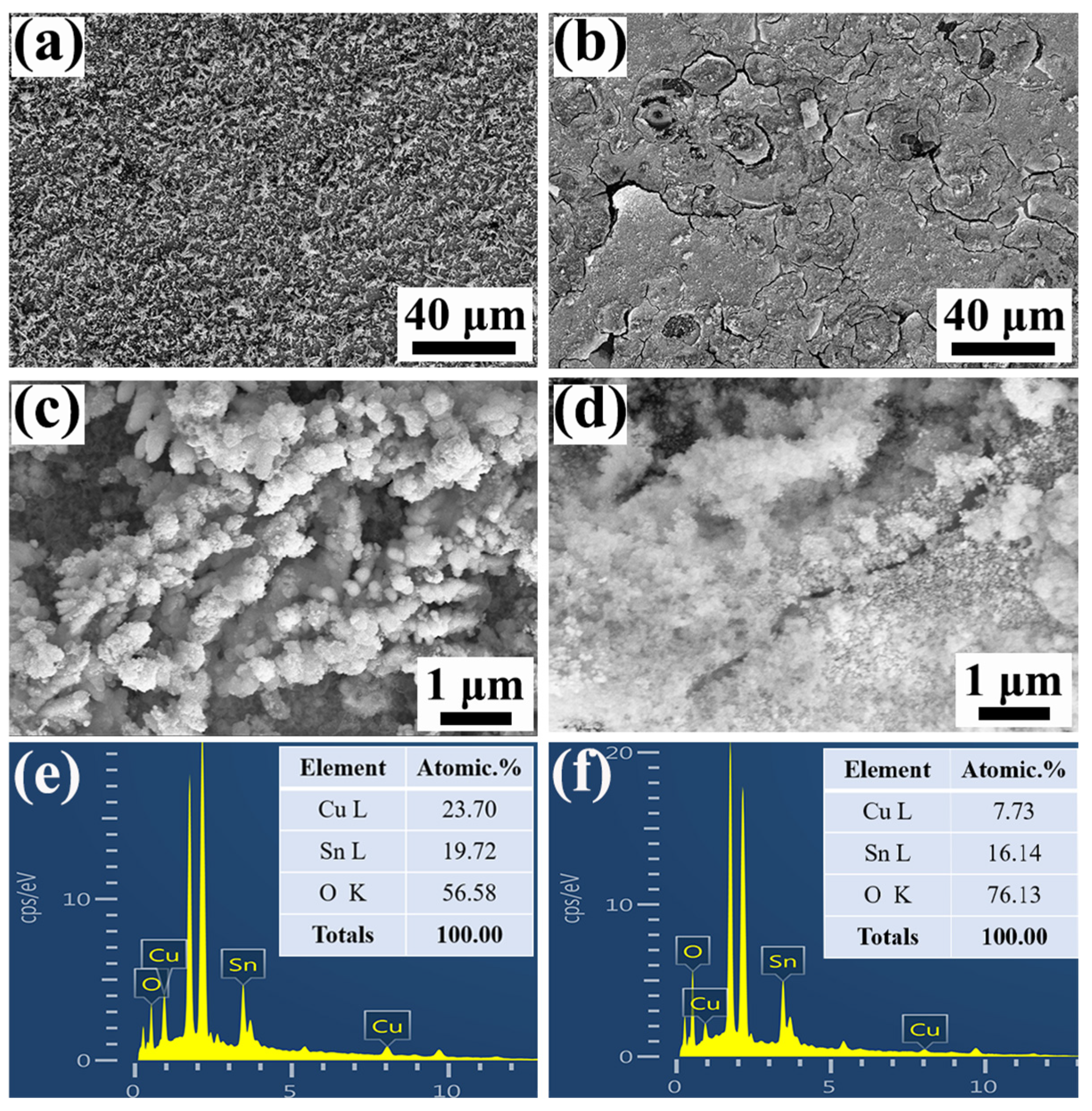


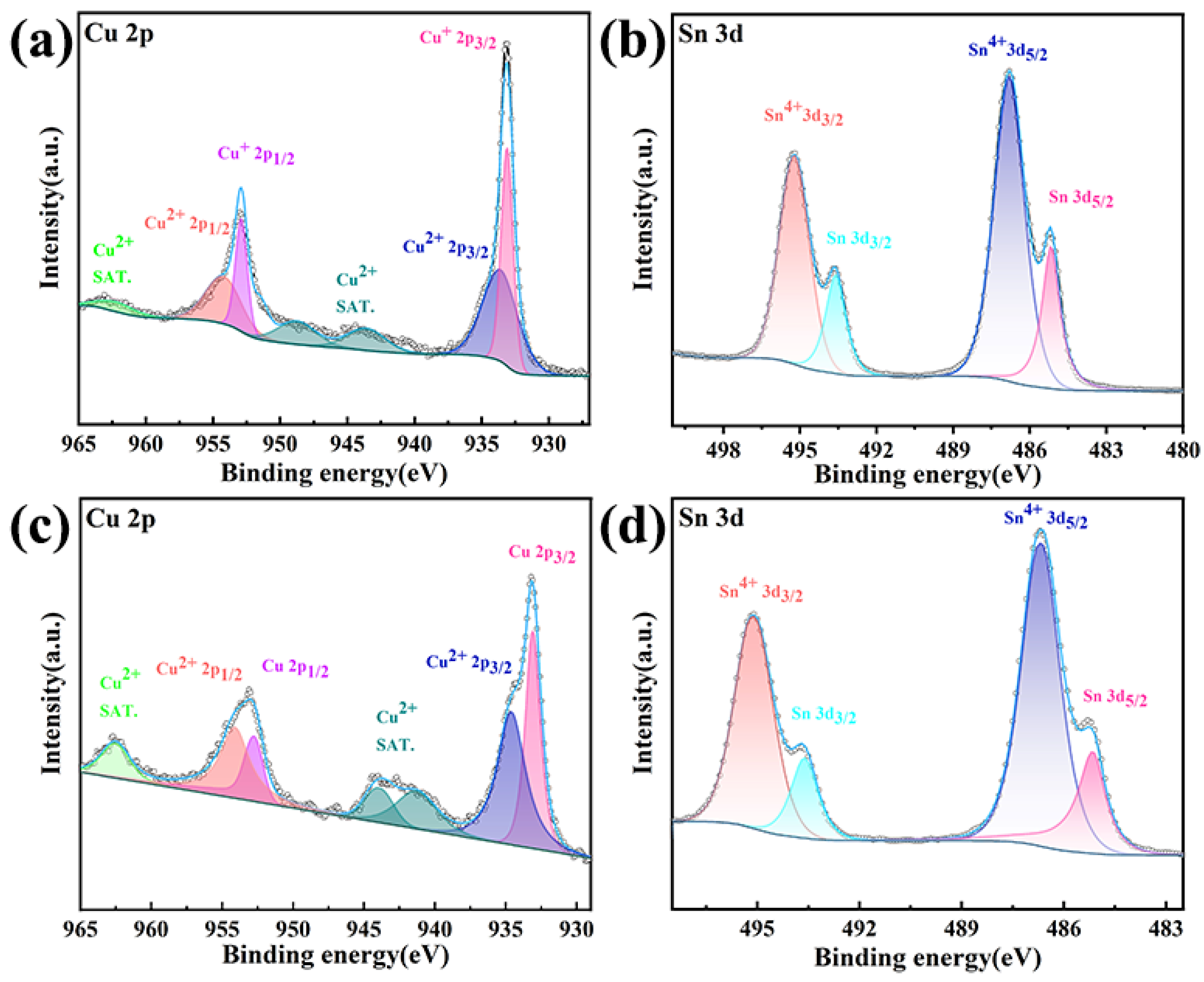
| Sample | Ecorr (V) | jcorr (mA cm−2) | Rp (Ω cm2) | βa (V dec−1) | βc (V dec−1) |
|---|---|---|---|---|---|
| Cu56Sn44 | −0.259 V | 9.456 × 10−6 | 0.35 × 106 | 5.367 | 2.920 |
| Cu43Sn57 | −0.186 V | 1.248 × 10−6 | 0.39 × 106 | 5.780 | 4.587 |
| Sample | Ecorr (V) | jcorr (mA cm−2) | Rp (Ω cm2) | βa (V dec−1) | βc (V dec−1) |
|---|---|---|---|---|---|
| Cu56Sn44 | −0.065 V | 5.384 × 10−5 | 1.21 × 105 | 9.978 | 6.032 |
| Cu43Sn57 | −0.028 V | 2.630 × 10−5 | 2.11 × 105 | 9.875 | 4.722 |
| Sample | Cu56Sn44 | Cu43Sn57 |
|---|---|---|
| Rs (Ω cm2) | 11.3 | 9.95 |
| Rct (Ω cm2) | 19,582 | 35,530 |
| CPE1-T (Sn Ω−1 cm−2) | 4.12 × 10−5 | 3.15 × 10−5 |
| CPE1-P | 0.85 | 0.93 |
| Sample | Cu56Sn44 | Cu43Sn57 |
|---|---|---|
| Rs (Ω cm2) | 16.15 | 12.48 |
| Rct (Ω cm2) | 12,056 | 27,479 |
| CPE1-T (Sn Ω−1 cm−2) | 4.58 × 10−5 | 1.16 × 10−5 |
| CPE1-P | 0.92 | 0.93 |
Disclaimer/Publisher’s Note: The statements, opinions and data contained in all publications are solely those of the individual author(s) and contributor(s) and not of MDPI and/or the editor(s). MDPI and/or the editor(s) disclaim responsibility for any injury to people or property resulting from any ideas, methods, instructions or products referred to in the content. |
© 2025 by the authors. Licensee MDPI, Basel, Switzerland. This article is an open access article distributed under the terms and conditions of the Creative Commons Attribution (CC BY) license (https://creativecommons.org/licenses/by/4.0/).
Share and Cite
Jiao, X.; Yang, Z.; Yan, J.; Zhang, J.; Chen, X.; Guan, R. Electrodeposition and Corrosion Behavior of Cu-Sn Alloys in 3.5 wt.% NaCl and 0.1 M HNO3 Solutions. Metals 2025, 15, 426. https://doi.org/10.3390/met15040426
Jiao X, Yang Z, Yan J, Zhang J, Chen X, Guan R. Electrodeposition and Corrosion Behavior of Cu-Sn Alloys in 3.5 wt.% NaCl and 0.1 M HNO3 Solutions. Metals. 2025; 15(4):426. https://doi.org/10.3390/met15040426
Chicago/Turabian StyleJiao, Xiye, Zhou Yang, Jie Yan, Jin Zhang, Xiaolin Chen, and Renguo Guan. 2025. "Electrodeposition and Corrosion Behavior of Cu-Sn Alloys in 3.5 wt.% NaCl and 0.1 M HNO3 Solutions" Metals 15, no. 4: 426. https://doi.org/10.3390/met15040426
APA StyleJiao, X., Yang, Z., Yan, J., Zhang, J., Chen, X., & Guan, R. (2025). Electrodeposition and Corrosion Behavior of Cu-Sn Alloys in 3.5 wt.% NaCl and 0.1 M HNO3 Solutions. Metals, 15(4), 426. https://doi.org/10.3390/met15040426








